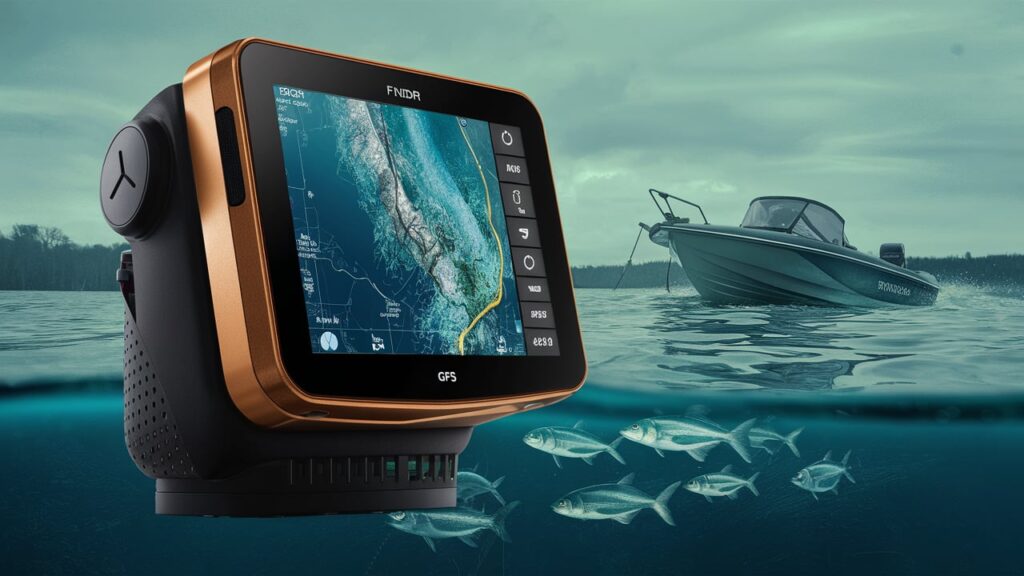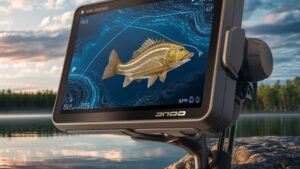Fish finders are essential tools for modern anglers. They help locate fish underwater, making fishing more efficient and enjoyable.
Understanding how fish finder technology works can greatly enhance your fishing experience. These devices use sonar to detect fish and underwater structures, displaying the information on a screen. For both beginners and seasoned anglers, knowing the ins and outs of fish finders can make a significant difference.
This post will dive into the basics of fish finder technology, explaining its key components and how to use it effectively. Whether you’re fishing in shallow waters or deep sea, mastering this technology can lead to more successful trips. Let’s explore how fish finders can transform your fishing adventures.

Introduction To Fish Finders
Anglers constantly seek tools to enhance their fishing experiences. Fish finders have become essential in modern fishing. These devices help locate fish underwater. They offer a significant advantage to both beginners and seasoned anglers.
What Is A Fish Finder?
A fish finder is an electronic device. It uses sonar technology to detect objects in water. This includes fish, vegetation, and the underwater structure. The device sends out sound waves that bounce off objects. These waves return to the device, creating an image on the screen. This helps anglers see what lies beneath the surface.
Importance For Anglers
Fish finders save time. Anglers no longer need to guess where fish might be. The device shows precise locations of fish. This increases the chances of a successful catch. Knowing the underwater environment is also crucial. Fish finders reveal the depth and structure of the water. This helps in understanding fish behavior and patterns.
How Fish Finders Work
Fish finders have revolutionized the way anglers locate fish. Understanding how these devices work can help you make the most of your fishing trips. This section will break down the basic principles and the sonar technology behind fish finders.
Basic Principles
Fish finders use sound waves to detect objects underwater. These devices send out sound pulses. When these pulses hit an object, they bounce back. The fish finder then measures the time it takes for the echoes to return. This helps it determine the distance to the object.
Fish finders display this information on a screen. You can see underwater structures, fish, and the bottom of the water body. This makes it easier to find and catch fish.
Sonar Technology
Sonar stands for Sound Navigation and Ranging. It is the main technology behind fish finders. Fish finders emit sonar waves into the water. These waves travel through the water until they hit an object.
The waves then return to the fish finder. The device calculates the distance based on the time it took for the waves to return. This data is then shown on the fish finder’s display. Different colors and shapes on the screen indicate various objects and depths.
Modern fish finders use advanced sonar technology. This includes features like CHIRP sonar, which sends a continuous range of frequencies. This provides more detailed and accurate information about the underwater environment.
Types Of Fish Finders
Fish finders are essential tools for anglers. They help locate fish and understand underwater environments. There are various types of fish finders available. Each type has unique features and benefits. Choosing the right one can improve your fishing experience.
Fixed Fish Finders
Fixed fish finders are permanently installed on boats. They offer detailed information about underwater structures. These devices usually have larger screens. This makes it easier to read the data. Fixed fish finders are ideal for serious anglers. They provide high accuracy and reliability. Installation requires some technical knowledge. But once installed, they are very easy to use.
Portable Fish Finders
Portable fish finders are versatile and convenient. They are perfect for shore fishing or small boats. These devices are easy to carry and set up. They often come with rechargeable batteries. Portable fish finders offer flexibility. You can use them in various fishing spots. They may have smaller screens than fixed models. But they still provide useful information. Portable fish finders are great for casual anglers.
Key Features To Consider
Explore key features like sonar technology, GPS integration, and display clarity. These aspects help anglers locate fish with precision. High-quality fish finders enhance fishing experiences.
When you’re choosing a fish finder, understanding the key features can make a world of difference in your angling success. The right fish finder will not only help you locate fish faster but also make your overall fishing experience more enjoyable. Let’s dive into some essential features you should consider.
Display Quality
The display quality of a fish finder can significantly affect how well you interpret the data. A high-resolution screen is crucial. It allows you to see clear images of what’s beneath your boat.
Consider the size of the display. A larger screen can show more detail and is easier to read, especially in bright sunlight.
Look for models with backlighting. This feature is handy during early morning or late-night fishing trips. The clearer the display, the better you can understand the underwater environment.
Frequency Settings
Frequency settings determine how well your fish finder can distinguish between different objects underwater. High-frequency settings (e.g., 200 kHz) provide detailed images but are best suited for shallow waters.
Lower frequencies (e.g., 50 kHz) penetrate deeper but offer less detail. This makes them ideal for deep-sea fishing.
Some fish finders come with dual-frequency options. This gives you the flexibility to switch between high and low frequencies depending on your fishing environment.
Choosing the right frequency can help you spot fish more accurately, increasing your chances of making a great catch.
Installation Tips
For anglers, installing a fish finder involves attaching the transducer to the boat’s hull. Proper positioning ensures accurate readings. Test the device in shallow water to confirm functionality.
Are you ready to dive into the world of fish finders? Before you can start reeling in those big catches, you need to get your fish finder set up correctly. Here are some essential installation tips to help you get started.
Mounting Options
Choosing the right mounting option is crucial. You have several choices depending on your boat type and fishing style.
Transom mounts are the most common. They are easy to install and perfect for smaller boats. Just make sure the transducer is below the waterline for accurate readings.
If you own a kayak or a canoe, consider a portable mount. These are versatile and can be moved between different boats.
For larger boats, through-hull mounts might be the best option. They provide the most accurate readings but require drilling a hole in your boat. This can be daunting, but the precision is worth it.
Each mounting option has its pros and cons. Think about your specific needs and choose accordingly.
Power Supply
Powering your fish finder is straightforward, but it’s vital to get it right. You don’t want to be out on the water with a dead device.
Most fish finders run on 12-volt batteries. Make sure your battery is fully charged before heading out. A dedicated marine battery is a good investment. It provides consistent power and lasts longer.
Wiring is another key aspect. Use marine-grade wires to prevent corrosion. Keep the wires as short as possible to reduce voltage drop.
Connect the fish finder directly to the battery. Avoid connecting it through other devices to prevent interference.
A clean power supply ensures your fish finder works efficiently. This translates to better performance and more fish in your net.
By following these tips, you’ll install your fish finder correctly and enjoy a better fishing experience. What’s your preferred mounting option? Share your thoughts in the comments below.
Using A Fish Finder Effectively
Fish finder technology helps anglers locate fish underwater with ease. It uses sonar to detect fish and display their location. This tool makes fishing more efficient and enjoyable.
Using a Fish Finder Effectively
Using a fish finder can transform your fishing experience. It’s like having an underwater guide. You can locate fish faster and spend more time catching them. But to make the most out of your fish finder, you need to know how to use it properly.
Reading The Display
The display is where all the magic happens. It’s your window to the underwater world. Start by understanding the basics. The top of the screen represents the surface, and the bottom shows the depth.
Pay attention to the color and intensity of the lines. Strong, thick lines usually indicate the bottom or a large object. Softer, scattered lines might be fish or other smaller objects.
Adjust the sensitivity settings. Too high, and you’ll see too much clutter. Too low, and you might miss the fish. Find a balance that works for your specific environment.
Identifying Fish
Identifying fish on the display can be tricky at first. Fish usually appear as arches or lines. The size and shape of the arch can give you clues about the size of the fish.
Small arches often represent smaller fish. Larger, more pronounced arches indicate bigger fish. Pay attention to the depth at which these arches appear.
Fish tend to group together. Look for clusters of arches. This could signal a school of fish. Note the movement. If the arches move consistently, they are likely fish.
Remember, practice makes perfect. Spend time experimenting with your fish finder. Soon, you’ll be reading the display and identifying fish like a pro.
Maintenance And Care
Maintaining and caring for your fish finder is crucial to ensure it performs well and lasts longer. Proper maintenance not only enhances the accuracy of your device but also prevents unnecessary repairs. Here’s how you can take care of your fish finder effectively.
Cleaning Tips
Keeping your fish finder clean is essential. After each fishing trip, wipe down the screen and body with a soft, damp cloth. Avoid using harsh chemicals which can damage the screen.
If you notice any salt or grime buildup, use a mild soap solution. Gently clean the surfaces and rinse with fresh water. Ensure all connections are dry before reattaching them to the device.
Don’t forget to clean the transducer. A dirty transducer can affect the accuracy of readings. Use a soft brush and mild detergent to remove any buildup. This simple step can significantly improve the performance of your fish finder.
Software Updates
Regular software updates are vital for optimal performance. Manufacturers often release updates to fix bugs and improve functionality. Check the manufacturer’s website or app for the latest updates.
Updating your fish finder’s software is usually straightforward. Connect the device to your computer or use a Wi-Fi connection. Follow the on-screen instructions to download and install updates.
Keeping the software up-to-date ensures you have the latest features and improvements. It can also help in providing more accurate readings, making your fishing experience more enjoyable.
Have you ever updated your fish finder’s software? If not, give it a try and see the difference it makes. Regular maintenance can save you from unexpected issues and enhance your fishing adventures.
Top Fish Finder Brands
Explore top fish finder brands known for advanced technology. These devices help anglers locate fish with ease. Brands like Garmin, Humminbird, and Lowrance offer reliable options.
When it comes to finding the best fish finder for your needs, there are a few brands that consistently stand out. Whether you are a seasoned angler or a beginner, having the right fish finder can make a world of difference. Let’s dive into some top fish finder brands that have earned a reputation for quality and reliability.
Garmin
Garmin is known for its advanced technology and user-friendly devices. Their fish finders often come with high-resolution displays and intuitive interfaces, making them easy to use.
I remember my first time using a Garmin fish finder. The clarity of the underwater images was astonishing. It felt like having a window into the underwater world.
Garmin’s models also offer GPS capabilities, which are essential for marking hotspots and navigating safely. If you like to explore new fishing spots, Garmin is a great choice.
Humminbird
Humminbird is another top contender in the fish finder market. They are well-regarded for their innovative features and robust build quality.
One of the standout features of Humminbird fish finders is their Side Imaging technology. This feature allows you to see what’s on either side of your boat, not just below it.
Imagine knowing there’s a school of fish just a few meters to your left. That’s the kind of edge Humminbird gives you. Their devices are also known for their durability, which is a big plus if you fish in tough conditions.
Are you ready to up your fishing game with the right technology? Choosing a reliable brand like Garmin or Humminbird could be your first step. What’s your favorite fish finder brand, and why? Share your thoughts in the comments!
Frequently Asked Questions
What Is The Technology Of Fish Finder?
Fish finders use sonar technology to detect underwater objects. They emit sound waves and measure reflections to locate fish.
What Is The Working Principle Of Fish Finder?
A fish finder works by emitting sonar waves that bounce off underwater objects. It then displays these objects on a screen.
How Does A Fish Finder Detect Fish?
A fish finder detects fish using sonar technology. It sends sound waves underwater, which bounce off objects. The device interprets these echoes to display fish locations.
What Is The Difference Between Sonar And Fish Finder?
A sonar detects objects underwater using sound waves. A fish finder specifically identifies fish and their depth in water.
Conclusion
Understanding fish finder technology can enhance your fishing trips. It helps you locate fish more quickly and effectively. Using these devices, you can spend more time catching and less time searching. With practice, your skills will improve. Remember to always check the device’s instructions.
Stay patient and enjoy the process. Fishing is about patience and enjoyment. Happy fishing!








